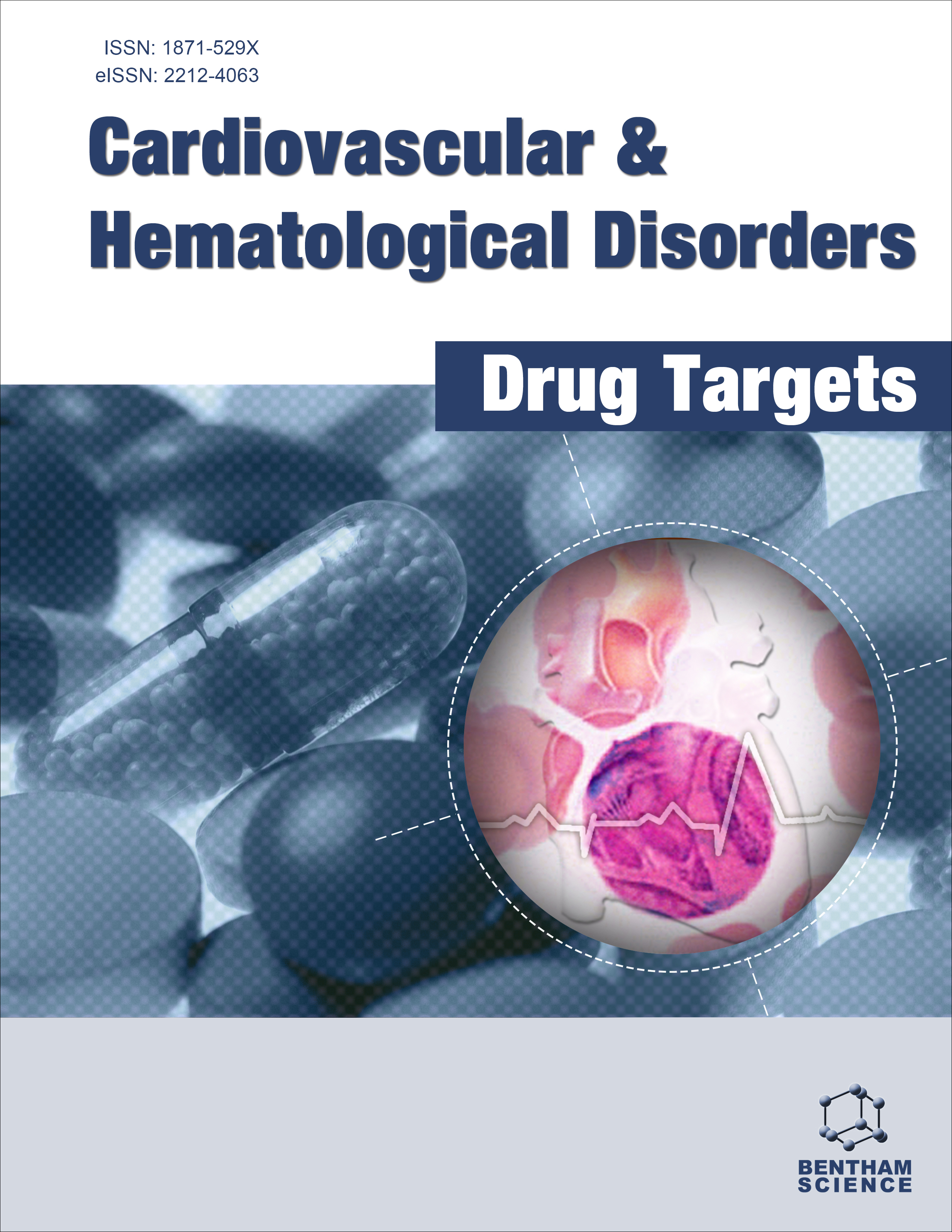- Home
- A-Z Publications
- Cardiovascular & Haematological Disorders - Drug Targets
- Previous Issues
- Volume 11, Issue 2, 2011
Cardiovascular & Haematological Disorders - Drug Targets - Volume 11, Issue 2, 2011
Volume 11, Issue 2, 2011
-
-
Pre-procedural Elevated White Blood Cell Count and Neutrophil-Lymphocyte (N/L) Ratio are Predictors of Ventricular Arrhythmias During Percutaneous Coronary Intervention
More LessAuthors: Saurav Chatterjee, Preeti Chandra, Gunjan Guha, Vikas Kalra, Anasua Chakraborty, Robert Frankel and Jacob ShaniAims: The absolute white blood cell (WBC) count and neutrophil to lymphocyte (N/L) ratio are predictors of death/myocardial infarction in patients who have undergone coronary angiography. We hypothesized that a pre-procedural elevated WBC count and an elevated N/L ratio would be a predictor of development of significant ventricular arrhythmias in subjects undergoing percutaneous coronary intervention (PCI). Metho Read More
-
-
-
Fibrosis, Enzymatic and Non-Enzymatic Cross-Links in Hypertensive Heart Disease
More LessAuthors: Michele M. Ciulla, Roberta Paliotti, Marina Carini, Fabio Magrini and Giancarlo AldiniMyocardial fibrosis is commonly observed in left ventricular (LV) hypertrophied heart during Arterial Hypertension. This pathological change coupled with vascular stiffening with aging and diabetes may reduce the cardiovascular system elasticity contributing to the functional impairment. Both the LV adaptive response to the increasing blood pressure and the oxidative damage contribute to myocardial fibrosis; in particular, reactive Read More
-
-
-
LPS In Patients With Left Ventricular Dysfunction Of Ischemic And Non-Ischemic Origin
More LessBackground: We decided to examine whether there are differences in the levels of lipopolysaccharide (LPS) in various groups of patients suffering from left ventricular dysfunction, requiring no intravenous therapy. Materials and methods: We studied 37 patients (ranging from 39 to 80 years, mean age of 59.8 years, SD 9.5) with left ventricular dysfunction caused by dilated cardiomyopathy, valvular heart disease or chronic is Read More
-
-
-
Anti-Platelet Therapy for Acute Coronary Syndrome: A Review of Currently Available Agents and What the Future Holds
More LessAuthors: F. A. Syed, J. H.N. Bett and D. L. WaltersDual anti-platelet therapy remains a cornerstone in the management of patients suffering from acute coronary syndromes (ACS). The combination of aspirin and clopidogrel has been shown to result in significant reductions in cardiovascular end points including recurrent infarction and death in several randomised control trial of patients with ACS. However, many patients still experience ischaemic events on the combination of a Read More
-
-
-
Synthesis and Antihypertensive Action of New Imidazo[1,2-a]pyridine Derivatives , non Peptidic Angiotensin II Receptor Antagonists
More LessThe synthesis and antihypertensive activity of a group of imidazo[1,2-a]pyridine is described. New synthesized compound have been tested both in vivo and in vitro as antagonists on Angiotensin AT1 receptor, and compared to Losartan, used as reference drug. Binding assay an Angiotensin AT1 receptor were carried on as well. Compounds 6b and 6g showed a potent antihypertensive activity and an high affinity on AT1 receptor.
-
-
-
Pexelizumab, an Anti-C5 Complement Antibody for Primary Coronary Revascularization: A New Insight from Old Versions
More LessBy Gen-Min LinPexelizumab, an anti-C5 complement antibody, as adjunctive therapy to reduce reperfusion injury after coronary revascularization in acute myocardial infarction and severe coronary artery disease had been approved in animal studies and further demonstrated clinical benefits in phase II study: the COMMA trial and phase III study: the PRIMOCABG trial. However, the negative results of pexelizumab were observed in the C Read More
-
-
-
Malignancy and Radiation-Induced Cardiotoxicity
More LessAuthors: Luigi Mancuso, Andrea Mancuso, Francesca Scordato, Michela Pieri and MC Eliana ValerioMediastinal mass radiotherapy as adjuvant or primary treatment is usually performed for lung, breast and oesophagus cancer, for lymphoma and thymoma. However, untoward late cardiac and vascular adverse effects can develop that were underrecognized in the past because a very long latency from exposure to clinical manifestations is needed. Moreover, the true cumulative incidence of these complications is hard to co Read More
-
-
-
Regulation of Endothelial Nitric Oxide Synthase in Pathophysiological Conditions
More LessThe nitric oxide (NO) cascade and endothelial NO synthase (eNOS) are best known for their role in endothelium-mediated relaxation of vascular smooth muscle (VSM). NO generated by eNOS has been established as a key regulatory signaling molecule in the vasculature. The activities of eNOS are controlled by intracellular calcium/calmodulin (CaM) and by binding of the molecular chaperone heat-shock protein 90 (Hsp90 Read More
-
-
-
Ox-LDL Particles: Modified Components, Cellular Uptake, Biological Roles and Clinical Assessments
More LessAuthors: Mohammad Najafi, Abazar Roustazadeh and Behnam AlipoorAmong concepts proposed to elucidate atherosclerosis process, the oxidative modification hypothesis is more considered to be investigated in studies. Based on the hypothesis, the LDL components are chemically modified due to oxidative stress within subendothelial space of vessels. The cells are able to recognize the oxidized LDL (ox-LDL) preparations so that inflammatory events spread through intracellular pathways an Read More
-
Volumes & issues
-
Volume 24 (2024)
-
Volume 23 (2023)
-
Volume 22 (2022)
-
Volume 21 (2021)
-
Volume 20 (2020)
-
Volume 19 (2019)
-
Volume 18 (2018)
-
Volume 17 (2017)
-
Volume 16 (2016)
-
Volume 15 (2015)
-
Volume 14 (2014)
-
Volume 13 (2013)
-
Volume 12 (2012)
-
Volume 11 (2011)
-
Volume 10 (2010)
-
Volume 9 (2009)
-
Volume 8 (2008)
-
Volume 7 (2007)
-
Volume 6 (2006)
Most Read This Month
Article
content/journals/chddt
Journal
10
5
false
en


